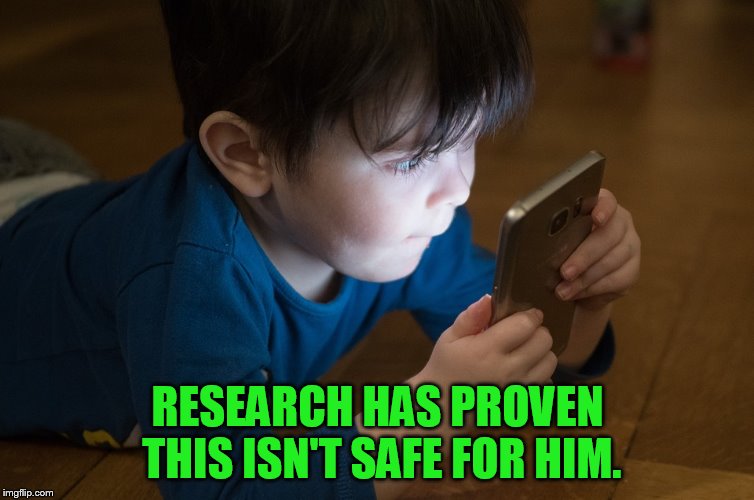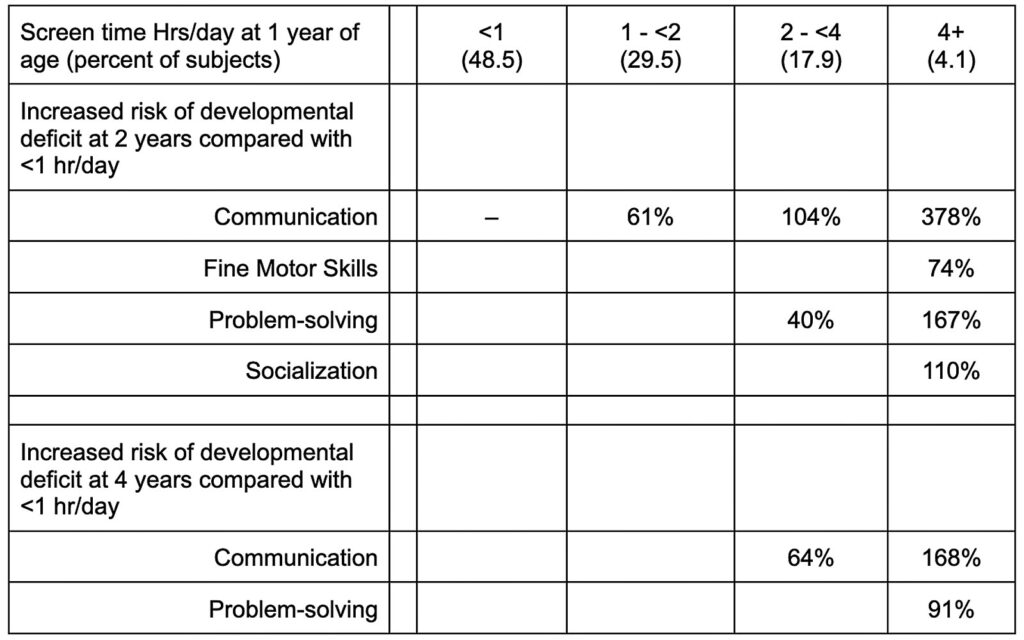 By B.N. Frank
By B.N. Frank
Warnings about kids and screen use (and exposure) are not new. Studies revealing that screen use (and exposure) cause numerous health issues for kids of all ages have been ongoing for years and continue to be published (see 1, 2, 3). If you are looking for new research that has concluded screens can cause problems specifically for infants, here ya go.
From Children’s Health Defense:
Screen Time for Babies: Unsafe at Any Dose?
A Japanese study reported that the more time per day 1-year-olds spent in front of screens, the worse their performance on standard developmental evaluations at ages 2 and 4. Delays in acquiring communication and problem-solving skills were the most prevalent and enduring effects.
One-year-olds who log more screen time are at higher risk for developmental delays at ages 2 and 4 — and the greater the screen time, the more serious and prolonged the deficits, according to a study published this month in JAMA Pediatrics.
The most pronounced effects involved delays in communication and problem-solving. Other measures of childhood development lagged at the two-year follow-up but vanished by age 4.
Miss a day, miss a lot. Subscribe to The Defender’s Top News of the Day. It’s free.
However, the researchers cited a 2020 study that also associated high device use with communication deficits — but conversely, found “better-quality screen use” involving educational content was linked to “stronger child language skills.”
Parents and babies co-viewing content, and a later onset of screen use, also seemed to be beneficial, according to the 2020 study.
The multi-university research team behind the JAMA Pediatrics study, led by first author Ippei Takahashi at the Graduate School of Medicine, Tohoku University in Sendai, Japan, defined screen time as the number of hours per day 1-year-olds spent watching television, playing video games and using mobile phones, tablets or other electronic devices.
RFK Jr./Hooker NEW book: Vax-Unvax. Order Now!
How the study was designed
Between July 2013 and March 2017, the Tohoku Medical Megabank Project Birth and Three-Generation Cohort Study recruited 7,097 mother-child pairs at 50 obstetric clinics and hospitals in the Miyagi and Iwate prefectures in Japan. Fifty-two percent of the subjects were boys.
Researchers grouped subjects according to one of four screen time exposure categories: less than one hour per day (48.5% of subjects), between one and two hours (29.5%), between two and four hours (17.9%) and four hours or more (4.1%).
The four exposure groups were matched for sex, maternal age and education, number of siblings, household income and demographics, and whether the mother had experienced postpartum depression.
Investigators applied the Japanese version of the Ages & Stages Questionnaires (3rd edition) to evaluate five developmental areas: communication, gross and fine motor skills, problem-solving and socialization.
Scoring in each area ranged from 0-60 points, with developmental delay defined as a score that was less than two standard deviations below the mean score. This high threshold means that to be counted, a value had to be lower than 95% of all other results.
What the researchers found
The researchers found that, generally, the more screen exposure at age 1, the greater the later deficit and the longer it persisted.
However, not all measures were negatively affected and not all deficits at age 2 were evident by age 4.
Table 1 summarizes Takahashi’s results.

Table 1. Increase, in percent, in the number of children failing to reach development milestones relative to the lowest-exposure group, for followups at age 2 (top rows) and age 4 (bottom rows).
For purposes of analysis, values from the three highest-exposure groups were compared to the result from the lowest-exposure babies and expressed as a percentage above that number.
For example in the table above, the value for “communication skills” in year 2 for the 1- to 2-hour group is 61% higher than the number for the <1 hour group. That means that, compared to the group with the lowest exposure, 61% more children in the second-lowest exposure group failed to meet a development milestone.
The most notable deficits arose for communication skills, which were evident in all groups at the two-year point and persisted at the four-year mark for the two highest-exposure groups.
Problem-solving deficits were observed for higher-exposure children as well but waned over time. Social development fell at two years for the highest-exposure group but disappeared by age 4.
The take-home lesson is that screen time affects some areas of childhood development but not others, and that not all associations persist.
For example, Takahashi found that the highest screen exposure times were associated with deficits in fine motor and social skills at age 2, but not at age 4. He proposed that these deficits themselves may be the reason children spent more time in front of screens, and not the other way around.
Order Now ‘The Wuhan Cover-up’ by RFK Jr.!
Device use guidelines
In 2016 the American Academy of Pediatrics (AAP) issued device usage guidelines for physicians, families and media companies.
The AAP recommended doctors initiate a conversation with families on device usage early, help them develop a media use plan, educate them about early brain development and the benefits of hands-on, unstructured and social play, and discourage any device exposure for children younger than 18 months.
For parents interested in introducing 18- to 24-month-olds to digital media, the physician group encouraged them to choose high-quality programming and personally oversee its use, advising that “Letting children use media by themselves should be avoided.”
Older children are OK with up to one hour of high-quality programming per day, but screens should be avoided during meals and right before bedtime. Parents should disallow fast-paced programs, apps with a lot of distracting signs or sounds and any violent content.
The AAP also cautioned parents to avoid using devices as babysitters:
“Although there are intermittent times (e.g., medical procedures, airplane flights) when media is useful as a soothing strategy, there is concern that using media as strategy to calm could lead to problems with limit setting or the inability of children to develop their own emotion regulation.”
In addition, it urged media developers to:
- Design programming appropriate for child development.
- Promote parent-child interaction and real-world skills.
- Eliminate commercial and “unhealthy” messaging.
- Create programs that do not automatically advance to the next episode or unit.
- Cease making apps for children younger than 18 months until evidence of benefit is demonstrated.
Despite pervasive device use among young children, very little research has addressed how screen time might affect a child’s development, according to Takahashi.
Most studies focused on a limited number of developmental milestones or did not directly link screen exposure at one specific point in time with an effect at another point.
Angelo DePalma, Ph.D., is a science reporter/editor for The Defender.
Sign up for free news and updates from Children’s Health Defense. CHD focuses on legal strategies to defend the health of our children and obtain justice for those injured. We can’t do it without your support
Research has also determined that exposure to blue light from screens (and other sources) is biologically harmful. Additionally, research has determined that exposure to electromagnetic fields (EMF) from cell phones and other wireless sources – including 5G – is biologically harmful as well with children being especially vulnerable to it. In fact, manufacturers are required to provide consumers with warnings about radiation exposure from cell phones and other wireless devices.
For several years already, tech experts (aka “Silicon Valley Parents”) have gone to great lengths to limit their own kids’ use and exposure to screens. This includes sending their kids to low-tech and/or no-tech schools, making their nannies sign “no screens” contracts, and spying on their nannies to make sure they didn’t break those contracts (see 1, 2, 3, 4). They obviously aren’t taking any chances with their own kids so maybe other parents shouldn’t either.
Activist Post reports regularly about unsafe technologies. For more information, visit our archives and the following websites:
- Environmental Health Trust
- Children’s Health Defense
- Electromagnetic Radiation Safety
- Physicians for Safe Technology
Become a Patron!
Or support us at SubscribeStar
Donate cryptocurrency HERE
Subscribe to Activist Post for truth, peace, and freedom news. Follow us on SoMee, Telegram, HIVE, Flote, Minds, MeWe, Twitter, Gab, and What Really Happened.
Provide, Protect and Profit from what’s coming! Get a free issue of Counter Markets today.


Be the first to comment on "Screen Time Can Cause Developmental Delays in Infants; “the greater the screen time, the more serious and prolonged the deficits”"